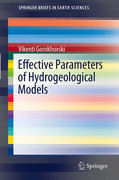
Models of geological objects are tools for interpolation and extrapolation ofavailable data in space and time continuously. Real structures of the objectsare unknown, and their models and simulated results carry uncertainty which cannot be evaluated in a provable way. The real issue is obtaining effective predictions in a reasonably defined sense. This requires a knowledge of mechanisms that convert actual geological properties into effective model parameters. These mechanisms are introduced in the book. They reveal that effective parameters are not statistics but characteristics optimizing the system made up by geological surroundings, their models, predictive problem formulations, including mathematical models of the simulated processes, boundary conditions, monitoring networks, criteria of efficiency and even by time. Examples of evaluatingand applying transformation for assigning effective parameters and solving inverse problems are presented. Numerous step-by-step tutorials help the reader to learn quickly. A special chapter on next generation. Flash introduces the reader to future applications. Includes ten tips on how to protect flash sites from hackers. INDICE: Foreword. Introduction. Engineering approach. Geostatical approach. Model identification. Transforming mechanisms to effective model parameters.Examples of linear transforming mechanisms. Examples of non-linear transforming mechannisms. Evaluation of transforming mechanisms. Inverse problems and transforming mechanisms. Conclusion. Afterword. References.
- ISBN: 978-3-642-23721-8
- Editorial: Springer Berlin Heidelberg
- Encuadernacion: Rústica
- Páginas: 161
- Fecha Publicación: 30/11/2011
- Nº Volúmenes: 1
- Idioma: Inglés
